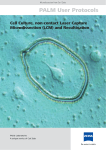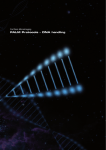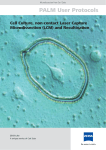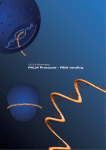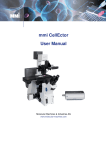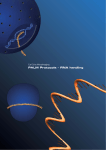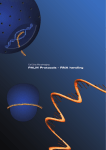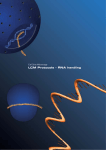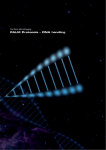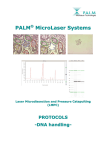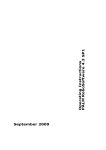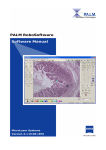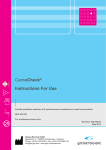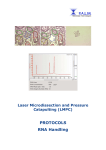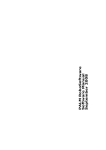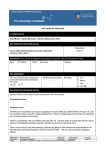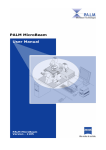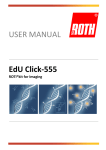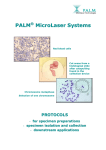Download Live Cells.indd
Transcript
Microdissection from Carl Zeiss PALM User Protocols Laser Capture Microdissection (LCM): Live cells and molecular analysis PALM Laboratories A unique service of Carl Zeiss PALM User Protocols Laser Capture Microdissection (LCM): Live cells and molecular analysis 1 Sample Preparation 3 1.1 Cultivation of adherent cells 3 1.2 Cytospin preparation of cells in suspension 4 1.3 Blood and tissue smear 4 1.4 Staining procedures of fixed cells 5 1.4.1 Hematoxylin/Eosin (HE) staining 5 1.4.2 Cresyl Violet 5 1.4.3 Methylene Blue 6 1.4.4 Nuclear Fast Red 6 2 Improved visulization of stained cells 7 2.1 PALM Diffusor 7 2.2 PALM AdhesiveCaps 7 3 Non-contact LCM 8 3.1 Holders for PALM Robostage 8 3.2 Collection devices 8 3.2.1 PALM CapMover 8 3.2.2 PALM RoboMover 8 3.3 Procedure: Non-contact LCM of fixed cells 9 4 Molecular analysis 10 4.1 Single cell analysis 10 4.1.1 AmpliGrid Technology 10 4.1.2 RNA from single cells 10 2 PALM User Protocols Laser Capture Microdissection (LCM): Live cells and molecular analysis 1 Sample Preparation 1.1 Cultivation of adherent cells Adherent growing cells are seeded into a DuplexDish 35 (Order No. 415101-4400-551) or DuplexDish 50 (Order No. 415101-4400-550) and are cultivated as usual up to the desired cell density. DuplexDish are especially adapted for non-contact Laser Capture Microdissection (LCM). The growth-surface of these culture dishes is optimized for attachment of many different cell types. Alternatively LumoxTM Dish 35 (Greiner bio-one, # 76077331) combined with MembraneRing 35 (Order No. 415101-4400-581) and LumoxTM Dish 50 (Greiner bio-one, # 76077410) with MembraneRing 50 (Order No. 415101-4400-580) can be used. The cells are grown directly on top of the membrane in an appropriate cell culture medium including all necessary supplements. Depending on the proliferation rate of the cell type the cells are ready for laser microdissection usually after 1-2 days. DuplexDish Adherently cultured cells can also be grown on FrameSlides PET (Order No. 415101-4401-055). These are recommended if weak fluorescence signals have to be detected, e.g. due to low signal to noise ratio. FrameSlides are inserted into a quadriPerm cell culture plate (Greiner bio-one, # 96077307) with the membrane-side facing the bottom of the plate (Zeiss symbol visible). Cells are seeded into the cavity of the FrameSlide in the desired cell count and covered with approximately 0.5 to 1 ml medium of choice. quadriPerm with FrameSlides 3 PALM User Protocols Laser Capture Microdissection (LCM): Live cells and molecular analysis 1.2 Cytospin preparation of cells in suspension Cytospins can be prepared on regular glass slides or on MembraneSlide 1.0 PEN (Order No.415101-4401-000). Procedure: • Wash adherent cells in the flask with Hanks’ solution and trypsinize. • Centrifuge 3 minutes at about 140g (800 rpm, Hettich Universal 32R) and discard supernatant. • Wash the pellet to remove medium and trypsin completely. • Centrifuge 3 minutes at about 140g (800 rpm, Hettich Universal 32R) and discard supernatant. • Resuspend the pellet in 5-10 ml Hanks’ solution. • Quantify the cells, e.g. using a Neubauer chamber. • Dilute up to 500 000 – 800 000 cells per ml. Use about 500 μl of the cell suspension per slide. • Centrifuge the cells to regular glass slides or to MembraneSlides in a cytocentrifuge for 3 minutes at 150g (1000 rpm, Hettich Universal 32R). • Remove carefully the supernatant from the slide using a pipette. • Let the cells air-dry over night at room temperature. • Dehydrate 1 minute with 70 % Ethanol. • Allow cytospin preparations to dry at room temperature before staining. 1.3 Blood and tissue smear • Distribute a drop of (peripheral) blood or material of a smear over the MembraneSlide. Be careful to avoid injuries in the membrane which would lead to leakage during fixation or washing. • Let smears air-dry shortly. • Fixate for 2 up to 5 minutes with 70% ethanol. • Dry at room temperature before staining. 4 PALM User Protocols Laser Capture Microdissection (LCM): Live cells and molecular analysis 1.4 Staining procedures of fixed cells In our experience almost any standard staining procedure can be used when you are interested in DNA (see protocols for DNA handling). Most standard histological stainings (e.g. HE, Methyl Green, Cresyl Violet, Nuclear Fast Red) are also compatible with subsequent RNA isolation. For isolation of high quality RNA use only freshly prepared and precooled staining solutions and take notice of our tips on handling RNA (please see RNA handling protocols). 1.4.1 Hematoxylin / Eosin (HE) staining of fixed cells HE-staining is used routinely in most histological laboratories and does not interfere with DNA preparation as well as RNA preparation if intrinsic RNase activity is low. The nuclei are stained blue, the cytoplasm pink/red. Procedure: • Quickly dip slide 5-6 times in (RNase-free) distilled water. • Stain 1-2 minutes in Mayer’s Hematoxylin solution (e.g. SIGMA # MHS-32). • Rinse 1 minute in (DEPC-treated) tap water or blueing solution. • Stain 10 seconds in Eosin Y (e.g. SIGMA # HT110-2-32). • Perform a quick increasing ethanol series (70 %, 96 %, 100 %). • Air-dry shortly. 1.4.2 Cresyl Violet This short staining procedure colors the nuclei violet and the cytoplasm weak violet. It is recommended for RNase-rich cells since all solutions contain high Ethanol concentrations. Because of the easy and short protocol we recommend the Cresyl Violet staining also for DNA. Procedure: • After fixation (1 minute, 70 % Ethanol) dip slide for 30 seconds into 1 % Cresyl Violet Acetate solution (*). • Remove excess stain on absorbent surface. • Dip into 70 % Ethanol. • Dip into 100 % Ethanol. • Air-dry shortly (1-2 minutes). (*) Dissolve solid Cresyl Violet Acetate (e.g. ALDRICH # 86,098-0) at a concentration of 1 % (w/v) in 50 % Ethanol at room temperature with agitation/stirring for several hours to overnight. Filter the staining solution before use to remove unsolubilized powder. (Sometimes variations in the purchased Cresyl Violet powder can lead to weaker staining results if the dye content of the LOT No. is below 75%). 5 PALM User Protocols Laser Capture Microdissection (LCM): Live cells and molecular analysis Note: In most cases the Cresyl Violet staining procedure described here will be sufficient for cell identification. If an enhancement of the staining is desired, reinforcement by two additional steps in 50% Ethanol (first before the staining in Cresyl Violet; second after the staining in Cresyl Violet) is possible. Additional intensification can be obtained by increasing the working temperature of all solutions to room temperature. The endogeneous RNase activity varies between different tissues. Therefore, when the short staining protocol is modified by additional steps (50% Ethanol) or by increasing the working temperature PALM Laboratories strongly recommend a quality control of the RNA (please see PALM RNA handling protocols). Ambion offers an LCM Staining Kit (# 1935) which also contains Cresyl Violet dye. When using this kit we recommend omitting the final Xylene step of the Ambion instruction manual because Xylene makes the tissue very brittle and reduces the adhesion of the section to the PEN membrane. 1.4.3 Methylene Blue Staining with Methylene Blue is applicable when interested in downstream DNA investigations. The nuclei are stained dark blue. Procedure: • After fixation (1 minute in 70 % Ethanol) incubate 5-10 minutes in Methylene Blue solution (0.05 % in water, SIGMA # 31911-2). • Rinse in distilled water. • Let air-dry at room temperature. 1.4.4 Nuclear Fast Red The nuclei are stained dark red, the cytoplasm light red. Procedure: • After fixation (1 minute in 70% Ethanol) incubate 5-10 minutes in Nuclear Fast Red solution (DAKO # S1963). • Rinse in distilled water. • Let air-dry at room temperature. 6 PALM User Protocols Laser Capture Microdissection (LCM): Live cells and molecular analysis 2 Improved visualization of stained cells For non-contact LCM embedding and glass covering of the specimen is inapplicable. Thus, the rough open surface of the section may result in impaired view of morphology. 2.1 PALM Diffusor The opaque glass of the PALM Diffusor diffuses the incident microscope light, which smoothens the harshness of contrast and, depending on material and staining, even minute details like nuclei and cell boundaries show up. Even slight differences in color become visible. PALM Diffusor 2.2 PALM AdhesiveCap The opaque filling of AdhesiveCaps clearly improves visualization of stained cells and tissue due to enhanced color balance and contrast, which makes the view comparable to those of coverslipped samples. For more details and handling, please see AdhesiveCap product information. AdhesiveCap 7 PALM User Protocols Laser Capture Microdissection (LCM): Live cells and molecular analysis 3 Non-contact LCM Please, additionally have a look into the PALM MicroBeam user manual. 3.1 Holders for PALM RoboStage Cells can be cultivated in DuplexDish 50, DuplexDish 35 or on FrameSlides PET. Cells in suspension can be spun down to MembraneSlides or regular glass slides (please see chapter 1 Sample Preparation). Depending on whether Dishes, FrameSlides, regular glass slides or MembraneSlides are used DishHolder 35 or 50 or SlideHolder 3x1.0 or 3x0.17 has to be used. These holders are adapted to the PALM RoboStage II. 3.2 Collection devices PALM RoboMover, PALM CapMover and LiveCell Collector are collection devices for positioning collector vessels over the sample. 3.2.1 PALM CapMover For slides and dishes SingleTube Collectors are offered. These SingleTube Collectors are designed to be equipped with 500 μl or 200 μl caps in order to enable the direct isolation of cells from a dish or a slide. PALM CapMover 3.2.2 PALM RoboMover PALM RoboMover is a device for highly automated harvesting and sorting of different kinds of microdissected specimen in a higher throughput process. The non-contact LCM process can be operated automatically or manually, respectively. PALM RoboMover is completely controlled by PALM RoboSoftware and can be equipped with different collectors, e.g. SlideCollector 48, CapturePlate Collector 96 and SingleTube Collectors. PALM RoboMover 8 PALM User Protocols Laser Capture Microdissection (LCM): Live cells and molecular analysis 3.3 Procedure: Non-contact LCM of fixed cells If you are interested in DNA, RNA or proteins after non-contact LCM, adherent cells growing in DuplexDishes or on FrameSlides, optional cytospin preparations, blood and cell smears can be fixed and dehydrated e.g. with 70 % Ethanol for 1-3 minutes. The cells can be stained subsequently. Procedure: • Find optimal laser settings for your MicroBeam: If LD 20x, LD 40x, or LD 63x objective is used adapt the working distance to different slides and DuplexDishes by moving the correction ring on the objective. Regular glass slide (1 mm thick) => 1, thin slide (0.17 mm thick) => dot, DuplexDish and FrameSlide between dot and 0. • Set Delta Laser Energy (difference between cutting and lifting energy) to 15-20, depending on the objective used and the size of the selected area. • Prepare an appropriate collection vial, e.g. AdhesiveCap. • Place the cap in the appropriate Collector, e.g. SingleTube Collector for dishes or slides. • Center the cap directly above the region of interest. • Select the cells of interest by any of the software marking tools. • Isolate the marked cells or areas using an adequate laser function, e.g. RoboLPC for cells on membrane or AutoLPC for cells directly on glass. Single cells on glass slides can be lifted just by a single laser pulse into the collection vial. • After non-contact LCM the lifted cells can be inspected by moving the RoboStage to the checkpoint position. Note: Especially for RNA experiments we recommend opaque AdhesiveCaps for stained material and clear AdhesiveCaps for unstained cells. The intention is to allow non-contact LCM without applying any capture liquid into the caps prior lifting. This minimizes activation of RNases. Beside the quick relocation of the lifted samples inside the cap due to instant immobilization, there is no risk of evaporation and crystal forming during extended specimen harvesting. For more details and handling, please see also AdhesiveCap product information. 9 PALM User Protocols Laser Capture Microdissection (LCM): Live cells and molecular analysis 4 Molecular analysis Molecular analyses including gene expression profiling of cells isolated by laser microdissection have become important methods for analyzing cellular behavior in a microscale and are used in research and clinical applications. For detailed protocols, tips, and tricks please see Protocols DNA Handling and Protocols RNA Handling. 4.1 Single cell analysis 4.1.1 AmpliGrid technology With RoboMover and SlideCollector 48 in a high throughput manner 48 reaction sites on the collection device can be operated in a single experiment. The AmpliGrid technology from Advalytix allows DNA amplification and cycle sequencing in an extremely low volume reaction format directly on chip by using single cells as the template source. By combination of both technologies (PALM MicroBeam and AmpliGrid) surpassing results can be generated in single cell analysis. This way one result for one single cell is obtained. There is no necessity to pool single cells for one reaction. But the individual outcome of 48 reactions can be pooled for an excellent and reliable result. 4.1.2 RNA isolation from single cells Carl Zeiss MicroImaging GmbH Location Munich Kistlerhofstr. 75 81379 München, Germany Phone: +49 (0) 89 90 9000-900 E-Mail: [email protected] Web: www.zeiss.de/microdissection July 2008 Non-contact LCM combined with real-time PCR e.g. Bio-Nobile PickPen® technology together with Quick-Pick TM mRNA nano kit allows rapid isolation of high-quality mRNA from small sample amounts down to one single cell. Please see PALM ApplicationNotes.










